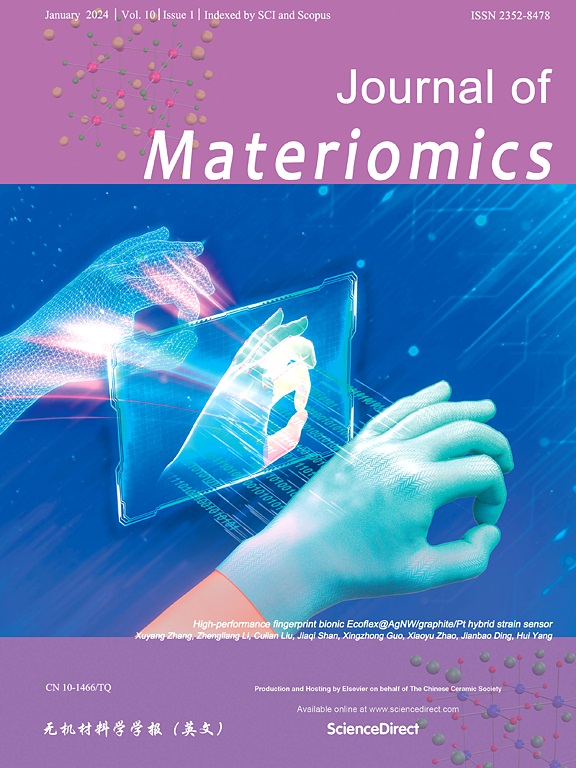Multifunctional energy storage and photoluminescence of Er-modified KNN-based transparent ferroelectric ceramics
IF 9.6
1区 材料科学
Q1 CHEMISTRY, PHYSICAL
引用次数: 0
Abstract
Against the backdrop of increasing miniaturization and integration of electronic components, the demand for materials with multifunctionality has increased significantly. Among these, transparent fluorescent ferroelectric ceramics exhibiting ferroelectricity, optical transparency, and photoluminescence (PL) have garnered significant attention. However, an interdependent relationship exists in a ferroelectric material among polarization, transparency, and photoluminescence, which presents a challenge for optimizing the coupling of optoelectronic properties. In this work, the doping concentration of Er3+ in 0.825(K0.5Na0.5)NbO3-0.175Sr(Sc0.5Nb0.5)O3: x%Er (x = 0–0.15) system was modulated by first-principle calculations through compositional design and performance-influencing-factor-analysis strategies. The experimental results showed that grain size of the ceramic was reduced to 28 μm at x = 0.05, concentration of vacancy defects in the lattice was low, and band gap value was increased to 3.105 eV. The multifunctional ceramic, while maintaining an excellent recoverable energy storage density (Wrec = 2.03 J/cm3) and energy storage efficiency (η = 75.67%), demonstrated a 56% (1100 nm) good near-infrared transmittance and upconversion photoluminescence properties at 527, 549 nm, and 667 nm exhibiting weak green, strong green, and weak red light, respectively. This study provides a theoretical foundation and new approach for realizing the multifunctionality of photoelectric couple by introducing rare earth elements as luminescent centers into ferroelectric ceramics.


铒修饰knn基透明铁电陶瓷的多功能储能和光致发光研究
在电子元件日益小型化和集成化的背景下,对多功能材料的需求显著增加。其中,具有铁电性、光学透明性和光致发光(PL)的透明荧光铁电陶瓷引起了人们的极大关注。然而,在铁电材料中,极化、透明度和光致发光之间存在着相互依赖的关系,这对优化光电特性的耦合提出了挑战。本文采用第一原理计算方法,通过组成设计和性能影响因子分析策略,对0.825(K0.5Na0.5)NbO3-0.175Sr(Sc0.5Nb0.5)O3: x%Er (x = 0-0.15)体系中Er3+的掺杂浓度进行了调制。实验结果表明,在x = 0.05时,陶瓷的晶粒尺寸减小到28 μm,晶格中空位缺陷的浓度较低,带隙值提高到3.105 eV。该多功能陶瓷在保持良好的可回收储能密度(Wrec = 2.03 J/cm3)和储能效率(η = 75.67%)的同时,在527、549和667 nm处具有56% (1100 nm)的良好近红外透射率和上转换光致发光性能,分别表现为弱绿光、强绿光和弱红光。本研究为将稀土元素作为发光中心引入铁电陶瓷中实现光电偶的多功能性提供了理论基础和新途径。
本文章由计算机程序翻译,如有差异,请以英文原文为准。
求助全文
约1分钟内获得全文
求助全文
来源期刊

Journal of Materiomics
Materials Science-Metals and Alloys
CiteScore
14.30
自引率
6.40%
发文量
331
审稿时长
37 days
期刊介绍:
The Journal of Materiomics is a peer-reviewed open-access journal that aims to serve as a forum for the continuous dissemination of research within the field of materials science. It particularly emphasizes systematic studies on the relationships between composition, processing, structure, property, and performance of advanced materials. The journal is supported by the Chinese Ceramic Society and is indexed in SCIE and Scopus. It is commonly referred to as J Materiomics.
 求助内容:
求助内容: 应助结果提醒方式:
应助结果提醒方式:


